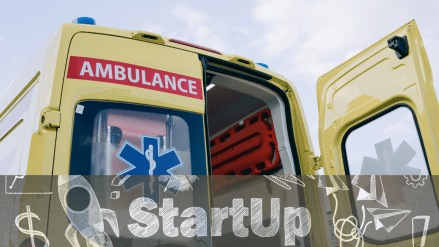Driven by the rising need for prompt medical help, the emergency medical service start-ups are witnessing an unprecedented growth.
As per Market Business Insights, the ambulance services segment alone was valued at $1.7 billion in 2024, and it’s expected to surpass $2.2 billion by 2030. The broader emergency medical services market is expected to reach over $3.5 billion by 2035.
The high growth potential of this niche segment has led to the entry of new players like Blinkit (promising 10-minute ambulance delivery service), and even the existing players are investing aggressively to increase their presence beyond the tier-I cities, and into newer verticals and technologies.
Hospital Gaps Open Doors for Start-ups
For a majority of private hospitals, the emergency response segment, which largely consists of ambulance services, has never been their core business area. This resulted in sub-optimal investments in emergency infrastructure and staff training by both private and government hospitals.
A 2021 report by NITI Aayog pointed out that the emergency and injury cases annually accounted for 9-13% of all patients presenting to a hospital. Even though 91% of hospitals had in-house ambulances, trained paramedics needed to assist ambulance services were present only in 34% facilities, the report noted.
Over the past few years, private emergency response start-ups are trying to plug this gap by handling the “emergency desks” at private hospitals through subscription-based tie-ups. Their offerings at hospitals include emergency fleet management, handling the calls, and real-time ambulance dispatch. A recent example is RED Health’s partnership with Dr. L.H. Hiranandani Hospital in Powai to launch central Mumbai’s first 5G-enabled ambulance network.
“We also have tie-ups with Fortis Healthcare in Delhi-NCR, Sterling Hospitals in Ahmedabad, the Vijaya Group of Hospitals in Chennai, and others. These partnerships allow us to integrate into the systems of hospitals, ensuring faster response and better clinical outcomes for patients,” said Prabhdeep Singh, founder & CEO of RED Health.
The other growth areas are corporates and public-private partnership (PPP). Take the case of Medulance which has partnered with the Delhi government to operate ambulance services in the city.
“We are the only players working with the government. Every state has its own ambulance service. The Delhi government has outsourced its services to us. We are managing their toll free number as well,” said Pranav Bajaj, co-founder at Medulance Healthcare. He says that the speed of the response time will be the key differentiator over the next five years. “The turnaround time depends on a lot of factors such as traffic conditions and road conditions. In that critical time period, we have ensured that the patient gets necessary help, and at the same time, we share their vital data with the hospital in real-time,” Bajaj said.
Tech-led Fleets and Corporate Partnerships
To make ambulances more accessible, almost all of these players are aggressively expanding their fleet with next-generation ambulances that are equipped with 5G connectivity, AI-powered diagnostic tools, and telemedicine capabilities. In addition, these ambulances also facilitate live video consultations, continuous transmission of patient data (via WhatsApp link) and remote intervention by experts during the transit period.
In January this year, Zenzo launched a fleet of 25,000 ambulances across 450 cities offering BLS (basic life support) ALS (advanced life support) and 5G-enabled ICU services while committing a response time of under 15 minutes.
As the need for healthcare services grow across sectors, this segment has also sustained traction from investors. Last month, Dial4242 raised Rs 9 crore in a pre-series A funding round led by IAN Group. The purpose of this capital infusion is to strengthen its ambulance availability across India by reducing its current turnaround time (TAT) from 12 minutes to under 8 minutes. The company will also invest in technology upgrades, marketing, expansion of medical centers in underserved areas.
Red Health’s Singh said that corporate partnerships is another growing vertical where the start-ups provide 24/7 ambulance access for employees, on-site paramedic support, preventive healthcare camps, and tech-enabled wellness integrations. “We are working with over 250 corporates, including Infosys, Wipro, and Amazon, to handle end-to-end emergency and wellness solutions on a pan-India basis,” Singh said adding that his company is expecting to grow at 65% in FY26 to cross Rs 200 crore in revenues.
It’s estimated that 80% of the ambulances are not equipped with trained paramedics, many of these service providers are also investing in a separate vertical that focuses on just training of individuals required in the emergency response setup.
An August 2025 report by Market Research Future said that the Indian emergency medical services market has various critical sectors such as hospitals, trauma centers, and ambulatory surgical centers. “Hospitals’ trauma centers are integral to the emergency medical response system, providing advanced medical interventions, critical care, and specialised services for trauma cases, which are increasingly prevalent in urban environments due to road accidents and industrial incidents. Additionally, ambulatory surgical centers are becoming increasingly vital as they provide outpatient surgical services, allowing for quicker recovery times and reducing the burden on hospital resources,” the report said.
